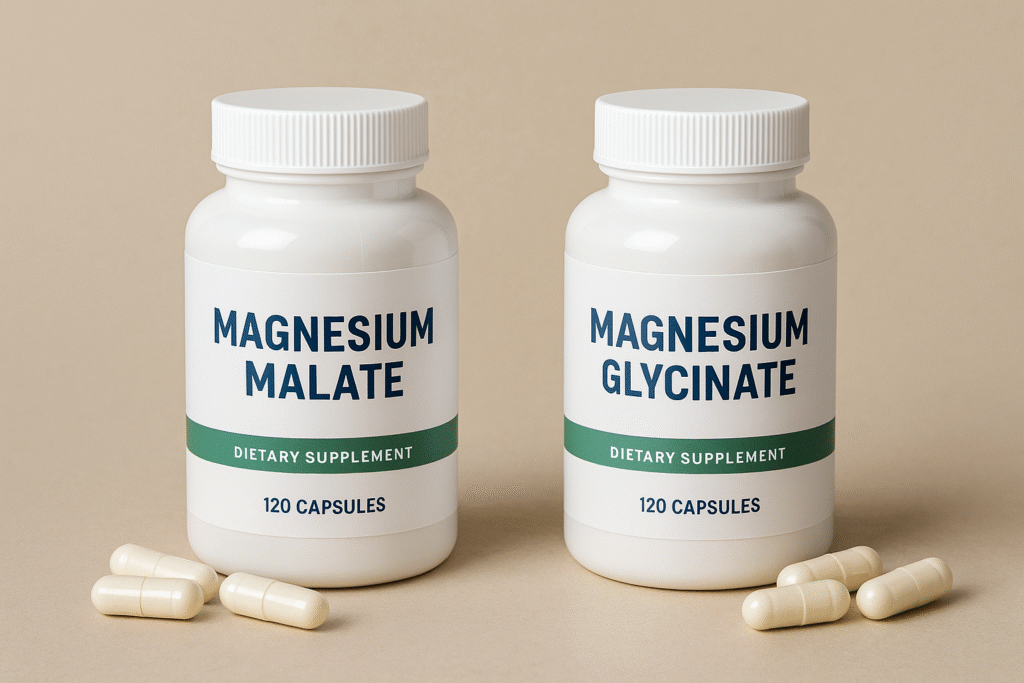
Magnesium is an essential mineral involved in over 300 biochemical processes in the body, including muscle function, nerve signaling, and energy production. Among its many forms, magnesium malate and magnesium glycinate are two popular options, each offering unique benefits.
Choosing the right one depends on your health goals and specific needs. Below is a detailed comparison of magnesium malate and magnesium glycinate to help you decide.
What Is Magnesium Malate?
Magnesium malate is a compound of magnesium and malic acid, a natural substance found in fruits like apples. Malic acid is involved in energy production within the Krebs cycle, making magnesium malate particularly beneficial for individuals with energy-related concerns.
Key Benefits of Magnesium Malate:
- Improves Energy Production: Supports ATP (energy) synthesis, making it ideal for combating fatigue or chronic fatigue syndrome (CFS).
- Reduces Muscle Pain: Often recommended for people with fibromyalgia or muscle soreness due to its muscle-relaxing properties.
- Gentle on Digestion: Typically well-tolerated and less likely to cause gastrointestinal upset compared to other magnesium forms.
Best For:
- People with low energy or chronic fatigue.
- Those experiencing muscle pain or fibromyalgia.
- Athletes needing muscle recovery and energy support.
Disclaimer: This post contains affiliate links. If you use these links to buy something, we may earn a commission at no extra cost to you. As an Amazon Associate we earn from qualifying purchases. Thank you for your support!
What Is Magnesium Glycinate?
Magnesium glycinate is a compound of magnesium and glycine, an amino acid with calming properties. Glycine acts as a neurotransmitter in the brain, promoting relaxation and improving sleep quality.
Key Benefits of Magnesium Glycinate:
- Promotes Relaxation and Sleep: Its calming effect makes it a top choice for reducing anxiety and improving sleep.
- Gentle on the Stomach: Known for excellent bioavailability and minimal risk of causing diarrhea.
- Supports Nerve and Muscle Health: Helps with tension, cramps, and overall muscle relaxation.
Best For:
- Individuals struggling with stress, anxiety, or insomnia.
- Those prone to digestive issues or sensitive to other magnesium forms.
- People seeking overall nerve and muscle relaxation.
Comparative Analysis
| Feature | Magnesium Malate | Magnesium Glycinate |
|---|---|---|
| Absorption | Highly bioavailable and well-tolerated | Highly bioavailable and gentle on the stomach |
| Primary Use | Boosting energy, reducing muscle pain | Calming the mind, improving sleep quality |
| Effect on Digestion | Less likely to cause digestive upset | Least likely to cause diarrhea |
| Energy Benefits | High (supports ATP production) | Minimal |
| Relaxation Benefits | Mild (relaxes muscles, reduces pain) | High (calms nerves, improves sleep) |
| Recommended For | Fatigue, fibromyalgia, physical recovery | Stress, anxiety, insomnia, muscle relaxation |
Which One Should You Choose?
- Choose Magnesium Malate If:
- You experience fatigue or low energy levels.
- You suffer from chronic muscle pain or fibromyalgia.
- You need a magnesium supplement for physical performance and recovery.
- Choose Magnesium Glycinate If:
- You struggle with anxiety or have trouble sleeping.
- You need a supplement that is easy on digestion.
- You’re looking for overall relaxation and muscle tension relief.
Dosage and Safety
Both forms are safe when taken within recommended doses, typically 200-400 mg per day of elemental magnesium. Always start with a lower dose to assess tolerance. Consult a healthcare professional before starting any new supplement, especially if you have a medical condition or take medication.
Frequently Asked Questions (FAQ)
What’s the difference between magnesium malate and magnesium glycinate?
Magnesium malate is combined with malic acid and supports energy production and muscle pain relief, while magnesium glycinate is paired with the calming amino acid glycine, making it ideal for relaxation, anxiety, and sleep support.
Which is better for fatigue: magnesium malate or glycinate?
Magnesium malate is generally better for fatigue because it plays a role in ATP (energy) production and is often used to combat low energy or chronic fatigue.
Which magnesium is best for anxiety and sleep?
Magnesium glycinate is the preferred choice for anxiety and sleep due to glycine’s calming effect on the nervous system and its ability to promote restful sleep without causing grogginess.
Can I take magnesium malate and glycinate together?
Yes, many people combine magnesium malate and glycinate to get the benefits of both energy support and relaxation. However, always consult a healthcare provider to ensure appropriate dosing and avoid excess intake.
Are these forms of magnesium gentle on the stomach?
Both forms are known for being well-tolerated:
– Magnesium malate is easier on digestion than magnesium oxide or citrate.
– Magnesium glycinate is considered one of the gentlest options, rarely causing diarrhea or stomach upset.
How much magnesium should I take per day?
Typical doses range from 200–400 mg of elemental magnesium per day, depending on your needs and tolerance. Start with a lower dose and adjust gradually under medical supervision if needed.
Are magnesium supplements safe for long-term use?
Yes, when taken as directed, both magnesium malate and glycinate are safe for long-term use. Just ensure you’re not exceeding the upper limit of total daily magnesium (around 350 mg from supplements, per most guidelines) unless advised by a doctor.
Conclusion
Magnesium malate and magnesium glycinate are both excellent choices for improving health but serve different purposes. Magnesium malate excels at boosting energy and relieving muscle pain, making it ideal for active individuals or those dealing with fatigue. On the other hand, magnesium glycinate is perfect for promoting relaxation, improving sleep, and reducing anxiety. Choosing the right form depends on your specific health goals, ensuring you get the most out of this essential mineral.


